StoryWeaver Spotlight: Pallavi Rao
Posted by Remya Padmadas on October 04, 2019Pallavi Rao has done her MA in English and loves music, literature and painting. She is the daughter of well-known Kannada writer Vaidehi, and has worked on a compilation of talks by eminent theatre personality Sri B.V Karanth (edited by Sri Muralidhar Upadhya). Pallavi has been teaching PU students in several places and currently resides in Delhi. She has translated several storybooks to Kannada including The Night the Moon Went Missing and A Whistling Good Idea on StoryWeaver.
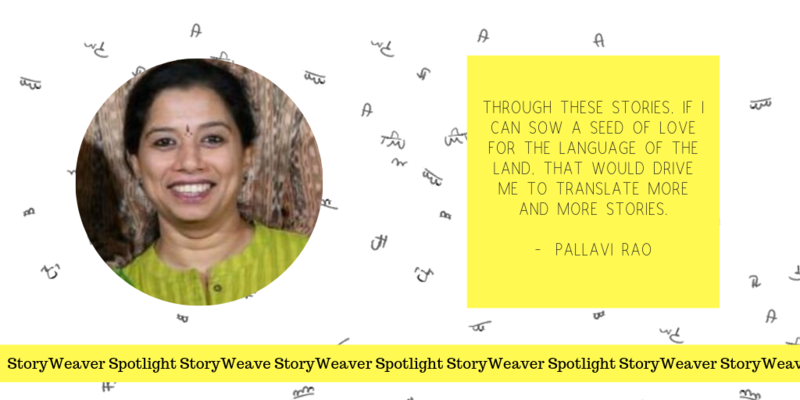
Q: You carve out time for translating children’s books from a busy life. What do stories in translation bring to young readers?
Young readers unknowingly come to know the culture, way of life and language at a young age itself. I think it is very important to imbibe these qualities at a young age.
Q: What is your personal relationship to language and/or translation?
Kannada being my mother tongue, I have read and listened to several great writers and thinkers in Kannada. I breathe my language and this helps me bring stories into Kannada.
Q: What is your take on translation?
Translation is a very responsible task. You have to translate the story keeping its original flavour intact and at the same time giving it the flavor of the language it is translated into. One should have a grip on both the languages i.e., from which you are translating and the one to which it is being translated into.
Q: Translating certain stories must have required a lot of research, especially when it came to STEM-related terms and concepts. For example, stories like A Whistling Good Idea. How did you explore new objects and concepts?
When I read a story to be translated, I dwell on it and begin thinking it in my language. It helps me to understand the story in local circumstances so that I can translate accordingly. While translating concept-oriented stories like ‘A Whistling Good Idea’, I felt it was such a nice way to make a child understand the concept in a playful manner. Difficult concepts are quite hard for children, but when the same concept is told through games, it becomes simple and hence is more understandable and easy for a child.
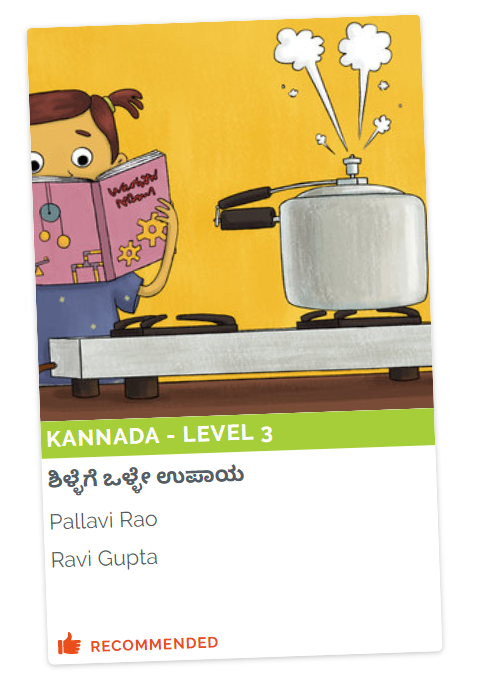
'A Whistling Good Idea', translated by Pallavi Rao
Q: You have contributed for us immensely. How has the StoryWeaver journey been? What is one big takeaway from this experience?
Overwhelming. By repeatedly wearing a child’s shoe while translating, it has made me more observant and my mind keeps weaving stories for children from whatever I observe around me!
Q: How do you feel when your story reaches the child?
If I can ignite the imagination of a child and add to the child’s vocabulary through my stories, nothing would be more satisfying.
Q: What is your key driver in taking up translation of stories into Kannada?
I have a very strong feeling towards my language. Children in big cities in my state rarely speak Kannada, which is very disturbing. Through these stories, if I can sow seed of love for the language of the land - that would drive me to translate more and more stories.
Q: How else do you think we can join hands to take more stories to more children in more languages?
India has abundant folk stories and poems for children in regional languages. They have to be made reachable to more children in other languages too. For example, in Kannada, we have stories of Panje Magesh Rao, Hoysala, Ullala Mangesh Rao, Ugrana Mangesh Rao, Rajaratnam and so on. Apart from translating stories from English to regional languages, I feel that we should also translate stories from regional languages to English and to other regional languages as well.
Q: When you have been given a story to translate, what is your process, and how long does it generally take?
I read the entire story two or three times, linger on the story and try to visualize the same while working on other chores. I try to keep the language simple, use more of sound words to make it more attractive and increase the vocabulary in children.
Q: What is the hardest thing about translating from English into Kannada? How do you navigate words or phrases that are tricky to translate?
Certain English concepts are not present in Kannada. For example, we don’t have a ‘cape’ in our costume. In such times we have to coin a word in Kannada and ensure that the image is translated successfully to the child.
Q: Do you have any advice for anyone interested in becoming a translator?
Keep the language as simple as possible and make it interesting for children by visualising the story yourself to get the best output.
Q: A book you'd like to recommend to other translators?
From the ones that I have translated it would be ‘A Whistling Good Idea’.
Q: Can you tell us anything about yourself and your job that would surprise us?
Cooking and painting interests me to a large extent. Experimenting techniques in both the fields are the same, I feel.
We would love for you to join the conversation by leaving your thoughts in the comments section, or on social media: Facebook, Twitter, Instagram
Be the first to comment.StoryWeaver Spotlight: Aparna Prasanna
Posted by Remya Padmadas on May 09, 2017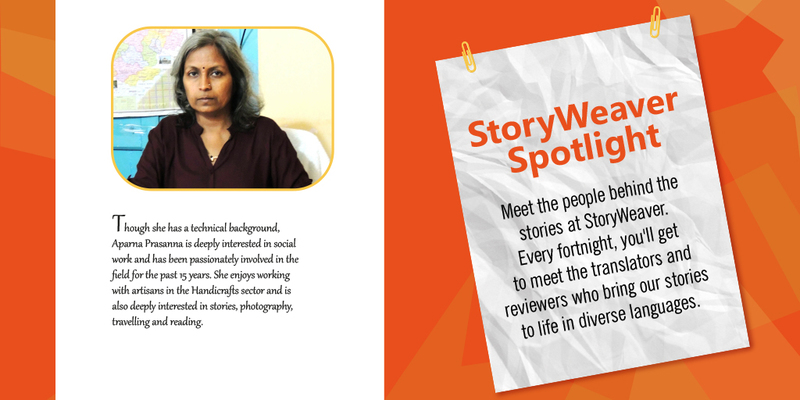
Q: What do you usually read? Which language do you prefer to read
Fiction, non-fiction, history, mythology. I read anything I can lay my hands on. I prefer to read in Kannada and English.
Q: Do you have a favourite book / author and why is it a favourite?
Yes, 'Mankutimmana Kagga' and 'Kaanoorina Heggadati' in Kannada are my favourite books.
Q: You have contributed for us immensely. How has the StoryWeaver journey been?
It has been a wonderful journey, I have enjoyed every bit of it.
Q: Could you share with us a story or anecdote from the translations / reviews? Or one big thing that you take away from this experience?
I have loved experiencing my childhood again with children surrounding me while I read them these stories.
Q: How does it feel when your story gets published online?
Oh! It brings a smile on my face.
Q: You have translated / reviewed a handful of stories for us. Which one has been your favourite and why?
There are two books I am particularly fond of: 'Jadav and the Tree Place' and The Wall Book.'Jadav and the Tree Place' is a very positive story showing how we can create wonders and that efforts do not go wasted. The Wall Book was full of information on human race and its civilisations, which I loved.
Q: What is your key driver in taking this up?
I do feel strongly about my language. And I enjoy translating stories for children so that they can read in their mother tongue.
Q: How else do you think we can join hands in taking bigger steps for children’s literature?
I think introducing story telling sessions, where the kids can narrate stories would be a good step.
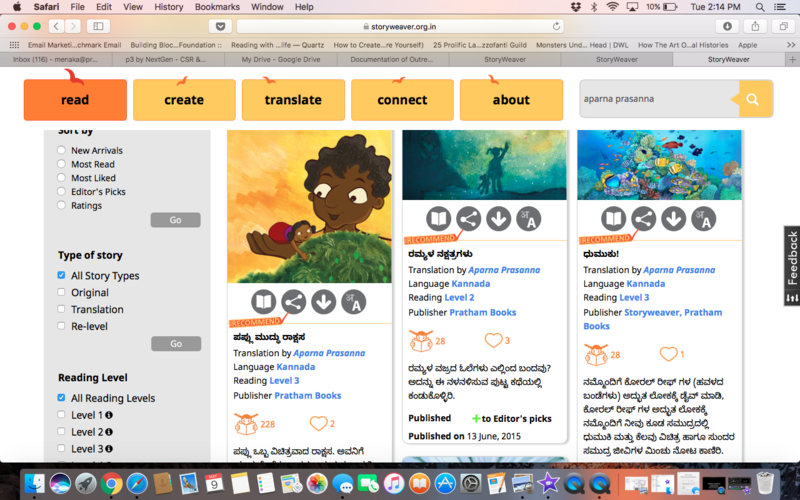
Q: How has the overall experience with StoryWeaver been?
ಅತ್ಯಂತ ತೃಪ್ತಿದಾಯಕವಾಗಿತ್ತು. ಅದ್ಭುತವಾದ ಕಲಿಕಾ ಅನುಭವವಾಗಿತ್ತು
Immensely satisfying and a wonderful learning experience.
Q: You seem to be having fun with the translations and reviews…could you share your 'secret recipe' for this with us?
I just love what am doing!
Be the first to comment.StoryWeaver Spotlight: Rishi Mathur
Posted by Remya Padmadas on January 27, 2017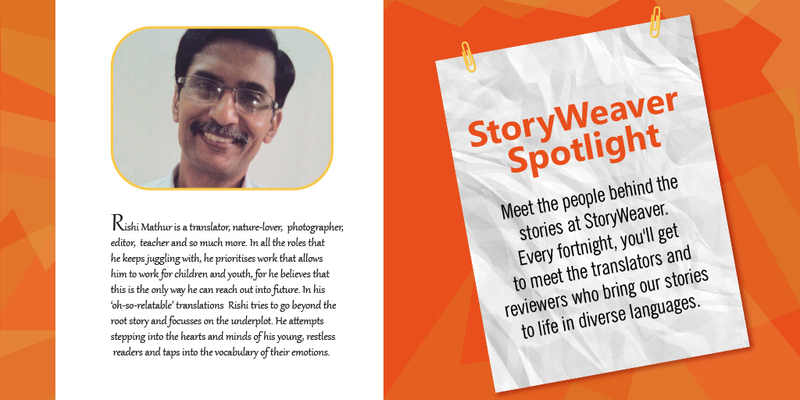
Q: What do you usually read? Which language do you prefer to read in?
I can read anything that I come across, but content on ‘how things evolve or change’ draws me most, whether it’s covered in philosophy, psychology, spirituality, life sciences, cosmology or for that matter, fiction, which I’m a bit sceptic about, in English.
Q: Is there a favourite book / author and why is it a favourite?
There are many, but a few of them always figure in my all-time favourite list:
'The Prophet' by Khalil Gibran for its profound thought on the basics of life, and simplicity of expression. 'Origin of Species' by Charles Darwin for the way he connected his observations with the realities of the natural world bit by bit to create this ‘enormous whole’ of knowledge. 'A Brief History of Time' by Stephen Hawkings for the way complex phenomena are explained with such clarity therein. 'Conversations with God' sequence of books by Neale Donald Walsch for the style and utility as manuals of spiritual understanding. 'Manwatching' by Desmond Morris, whom I’ve always deemed as my master in absentia, for the rich scientific study in non-verbal communication it is. And all the books by Osho, the great master, whom I could never meet. Though I learned a lot from his mate Dowser S Bhan of Nepal.
Q: You have contributed for us immensely. How has the StoryWeaver journey been?
A: Fantastic! Working for the young readers is always a joy! Wish, it continues as long as I can think and see.
Q: How does it feel when your story gets published online?
A: Nice. But, anticipating another one in my inbox for translation feels a lot better!
Q: You have translated / reviewed a handful of stories for us. Which one has been your favourite and why?
A: Ladle ka Dhol, the very first I translated still tops the list of my favourites. Also developed a special relationship with the Brahmaputra, as I travelled into Tibet through its text!
Q: What is your key driver in taking up these translations?
A: Frankly speaking, being a communicator, I do feel ‘something for all languages,’ but I’m more bent towards the non-verbal aspects, so the key driving force behind translating books or writing something is usually for having the remittances credited into my bank account.
Q: How else do you think we can join hands in taking bigger steps for children’s literature?
A: We can. Through greater and more informal outreach programme. I am really grateful to Pratham Books for giving me an opportunity to interact with young readers in the Pink City during Jaipur Literature Festival. Sharing in person, live interactions by people from the publishing trade can take literature and readership farther than anything else.
Q: How has the overall experience with SW been?
प्रथम बुक्स और स्टोरी वीवर की श्रेष्ठ बाल कथाएं मूलतः चाहे किसी भाषा में लिखी गयी हों, नन्हें पाठकों की दिलचस्पी बनाए रखने के लिए अनुवादक को भाषा की सीमा से पार जाकर, बालमन की कोमल भावनाओं और कथावस्तु से मेल खाती शब्दावली का ध्यान रखना ज़रूरी होता है। ताकि कहानी परायी सी न लगे। यह चुनौती बार-बार सामने आयी। और कामयाबी के साथ इसका सामना किया जिससे ख़ूब ख़ुशी मिली। रचनात्मकता के ऐसे अवसर एक अनुवादक को लेखक के बिकलकुल क़रीब पहुंचने का एहसास कराता है। दूसरों की कलम की जायी कहानी अपनी सी लगने लगती है। ऐसी दत्तक रचनाओं को पोसने का मौक़ा देने के लिए प्रथम बुक्स और स्टोरी वीवर के संपादक मंडल का आभार। इस सुखद स्वाद में जोश का तड़का लगाने का काम किया प्रथम की युवा संपादक आमना सिंह ने। झटपट काम पूरा करने का दबाव बनाने के लिए छुट्टी के दिन भी ख़ुद लगातार संपर्क बनाए रखकर ऐसी चुनौतीपूर्ण समय सीमा में काम करवाया कि हैरान हूं, पर ख़ुश हूं।
The overall experience was good. It was especially nice, because of the great motivation offered by the Pratham Books' team who sounded hard-pressed for deadlines even on Sundays, making me work odd hours at breakneck speeds, making me feel more alive and kicking than I actually am?
Q: You wear many hats - which one is your favourite?
A: I’ve always been a nature lover, and will always be one! But being in the field of communication, I had to yield different tools during different phases of my career, more so for survival than anything else; starting with illustration work for a newspaper, to photography, project documentation for NGOs, new-reporting, editing, television production, research, teaching, translations, and even writing SOPs for students applying for overseas education and finally counselling. Working with children is best, and working for them is next!
Be the first to comment.